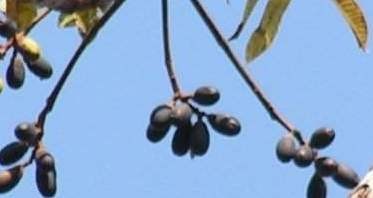Bush candle
(Canarium schweinfurthii)

Description
Canarium schweinfurthii (commonly known as the bush candle, African olive, African elemi, or canarium), is a species of large tree native to tropical Africa. Names in many African languages are variations of mupafu. Because of similarities in their fruit and leaves, African elemi may be confused with Dacryodes edulis. African elemi is found from the coast of Nigeria, Angola to Uganda. The African elemi tree is one of several sources of the economically useful oleoresin known elemi. In West Africa this resin is traditionally burned for fumigating dwellings and mixed with oil for body paint. African elemi bears edible fruit with a thick, dense, hard shell. The hard stones of its fruit are used for traditional divination among Plateau speakers in the Middle Belt of central Nigeria. Canarium is a genus of about 100 species of tropical and subtropical trees, in the family Burseraceae. They grow naturally across tropical Africa, south and southeast Asia, Indochina, Malesia, Australia and western Pacific Islands; including from southern Nigeria east to Madagascar, Mauritius, Sri Lanka and India; from Burma, Malaysia and Thailand through the Malay Peninsula and Vietnam to south China, Taiwan and the Philippines; through Borneo, Indonesia, Timor and New Guinea, through to the Solomon Islands, Vanuatu, New Caledonia, Fiji, Samoa, Tonga and Palau. Canarium species grow up to large evergreen trees of 40–50 m (130–160 ft) tall, and have alternately arranged, pinnate leaves. They are dioecious, with male and female flowers growing on separate trees. The trees and their edible nuts have a large number of common names in their range. These include Pacific almond, canarium nut, pili nut, Java almond, Kenari nut, galip nut, nangai, and ngali.
Taxonomic tree:







